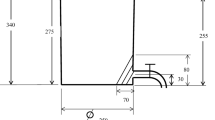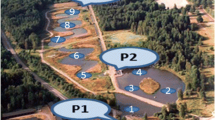Abstract
As in most large capital cities, urban stormwater discharging into Port Jackson (Sydney) is highly enriched in a wide range of contaminants, which has resulted in degradation of the receiving basin waters and bottom sediments. The objective of the current investigation was to determine the removal efficiency of contaminants in urban stormwater by a wetland constructed in the Sydney catchment. The wetland (700 m2) drains a residential urban catchment of about 480,000 m2 comprising predominantly houses, streets, gardens, and street parking areas. Samples of stormwater influent and effluent were obtained during rainfall events between April and June 2000. Eight samples were collected at the inlet and outlet to the wetland during each event and analyzed for nutrients, trace metals, total suspended solids (TSS), and organochlorine pesticides and polycyclic aromatic hydrocarbons (PAHs). Water quality parameters (temperature, dissolved oxygen, pH, turbidity, conductivity) were measured concurrently. The average removal efficiency of trace metals Cr, Cu, Pb, Ni, and Zn was 64%, 65%, 65%, 22%, and 52%, respectively for the six events measured, whereas for Fe and Mn, removal efficiencies were negative for most events (mean—84% and—294%, respectively). The average removal efficiency of NOx and TN was 22% and 16%, respectively. The average removal efficiencies of total Kjeldahl nitrogen (TKN) and total phosphorus (TP) were 9% and 12%, respectively. During four high-flow events, the removal efficiency of TSS in stormwater effluent from the wetland was between 9% and 46%; however, substantially higher TSS concentrations were observed in effluent than influent waters during two very high-flow events (removal efficiency—98% and—67%). Fecal coliform counts in the stormwater in this catchment are high (maximum: 620,000 cfu/100 ml), but mean removal efficiency was 76% (range 26% to 98%) during the four high-flow events monitored. Nevertheless, most samples from the outflow exceeded the Public Health criterion for secondary contact (e.g., boating) of 1000 cfu/100 ml. Concentrations of organochlorine pesticides and PAHs in stormwater were below analytical detection. Although highly variable, lower concentrations of Cr, Cu, Ni, Pb, Zn, NOx, TN, and fecal coliform in the stormwater effluent compared to influent waters indicates that the wetland was moderately efficient in removing contaminants from urban stormwater.
Similar content being viewed by others
Literature Cited
ANZECC. 1992. Australian Water Quality Guidelines for Fresh and Marine Waters. Australian and New Zealand Environment and Conservation Council, Canberra, Australia.
ANZECC/ARMCANZ. 2000. Australian and New Zealand Guidelines for Fresh and Marine Water Quality. Volume 1, Section 3.5—Sediment Quality Guidelines. Australian and New Zealand Environment and Conservation Council, and Agriculture and Resource Management Council of Australia and New Zealand, Canberra, Australia.
Backstrom, M. 2002. Sediment transport in grassed swales during simulated runoff events. Water Science and Technology 45:41–49.
Barbosa, A. E. and T. Hvitved-Jacobsen. 1999. Highway runoff and potential for removal of heavy metals in an infiltration pond in Portugal. The Science of the Total Environment 235:151–159.
Birch, G. F., B. Eyre, and S. E. Taylor. 1999. The distribution of nutrients in bottom sediments of Port Jackson (Sydney Harbour), Australia. Marine Pollution Bulletin 38:1247–1251.
Birch, G. F. and S. E. Taylor. 1999. Source of heavy metals in sediments of Port Jackson estuary, Australia. The Science of the Total Environment 227:123–138.
Birch, G. F. and S. E. Taylor. 2000. The distribution and possible sources of organochlorine residues in sediments of a large urban estuary, Port Jackson, Sydney. Australian Journal of Earth Sciences 47:749–756.
Brezonik, P. L. and T. H. Stadelmann. 2002. Analysis and predictive models of stormwater runoff volumes, loads, and pollutant concentrations from watersheds in the Twin Cities metropolitan area, Minnesota, USA. Water Research 36:1743–1757.
Carleton, J. N., T. J. Grizzard, A. N. Godrej, and H. E. Post. 2001. Factors affecting the performance of stormwater treatment wetlands. Water Research 35:1552–1562.
Crites, R. W. 1992. Design criteria and practice for constructed wetlands. Proceedings IAWQ Wetlands Systems Conference, Sydney, Australia.
Crites, R. W., G. D. Dombeck, R. C. Watson, and C. R. Williams. 1997. Removal of metals and ammonia in constructed wetlands. Water Environment Research 69:132–135.
Davis, A. P., M. Shokouhian, H. Sharama, and C. Minami. 2001. Laboratory study of biological retention for urban stormwater management. Water Environmental Research 73:5–14.
EPA. 1997. Managing Urban Stormwater—Treatment Techniques. New South Wales Environment Protection Authority, Sydney, Australia. Report No. 97/97.
Gersberg, R. M., S. R. Lyon, B. V. Elkins, and C. R. Goldman. 1985. The removal of heavy metals by artificial wetlands. Proceedings of the Water Reuse Symposium III, Future of Water Reuse. AWWA Research Foundation. Sydney, Australia.
HCC. 2000. Rehabilitation of Riverwood Wetland. Hurstville City Council, Hurstville, Australia. Final Report.
Irvine, I. and G. F. Birch. 1998. Distribution of heavy metals in surficial sediments of Port Jackson, Sydney, Australia. Australian Journal of Earth Sciences 45:169–174.
Lenehan, S. M. 1992. Wetland systems in stormwater pollution control. Proceedings of the AC Wetlands Systems Conference, Sydney, Australia.
LPRSWMP. 1999. Lower Parramatta River Stormwater Management Plan for Lower Parramatta River Stormwater Management Councils, Woodlots and Wetlands. Molino Stewart Environmental Services, Robyn Tuft and Associates and Lawson and Treloar, Sydney, Australia.
NSW EPA. 1995. Harbourwatch Season Report. New South Wales Environmental Protection Authority, Sydney, Australia.
McCready, S., D. Slee, G. F. Birch, and S. E. Taylor. 2000. The distribution of polycyclic aromatic hydrocarbons in surficial sediments of Sydney Harbour, Australia. Marine Pollution Bulletin 40:999–1006.
Page, C. A., J. S. Bonner, T. J. McDonald, and R. L. Autenrieth. 2002. Behavior of a chemically dispersed oil in a wetland environment. Water Research 36:3821–3833.
Reed, S. C., R. W. Crites, and E. J. Middlebrooks. 1995. Natural Systems for Waste Management and Treatment. 2nd ed. McGraw-Hill Inc., New York, NY., USA.
Schulz, R., and S. K. C. Peal. 2001. Effectiveness of a constructed wetland for retention of nonpoint-source pesticide pollution in the Lourens River catchment, South Africa. Environmental Science and Technology 35:422–426.
Smith, L. G., T. J. Carlisle, and S. N. Meek. 1993. Implementing sustainability: the use of natural channel design and artificial wetlands for stormwater. Journal of Environmental Management 37:241–257.
Tilley, D. R. and M. T. Brown. 1998. Wetland networks for stormwater management in subtropical urban watersheds. Ecological Engineering 10:131–158.
Walker, T. A. and S. Hurl. 2002. The reduction of heavy metals in a stormwater wetland. Ecological Engineering 18:407–414.
Walker, T. A., R. A. Allison, T. H. F. Wong, and R. M. Wootton. 1999. Removal of suspended and associated pollutants by a CDS gross pollutant trap. Cooperative Research Centre for Catchment Hydrology, Department of Civil Engineering, Monash University, Caulfield, Victoria, Australia. Report 99/2.
WRCS. 1997. Rehabilitation of Riverwood Wetland, Review of Environmental Factors, Water Resources Consulting Services, Report prepared for Hurstiville Council, Hurstiville, Australia.
WRCS. 1998. Operation and Maintenance Plan, Riverwood Wetland Rehabilitation. Water Resources Consulting Services, Report prepared for Hurstville Council, Hurstville, Australia.
Widerlund, A. 1996. Early diagenetic remobilization of copper in near-shore marine sediments: a quantitative pore-water model. Marine Chemistry 54:41–53.
Wood, S. W. and M. L. Shelly. 1999. A dynamic model of bioavailability of metals in constructed wetland sediments. Ecological Engineering 12:231–252.
Author information
Authors and Affiliations
Rights and permissions
About this article
Cite this article
Birch, G.F., Matthai, C., Fazeli, M.S. et al. Efficiency of a constructed wetland in removing contaminants from stormwater. Wetlands 24, 459–466 (2004). https://doi.org/10.1672/0277-5212(2004)024[0459:EOACWI]2.0.CO;2
Received:
Revised:
Accepted:
Issue Date:
DOI: https://doi.org/10.1672/0277-5212(2004)024[0459:EOACWI]2.0.CO;2




